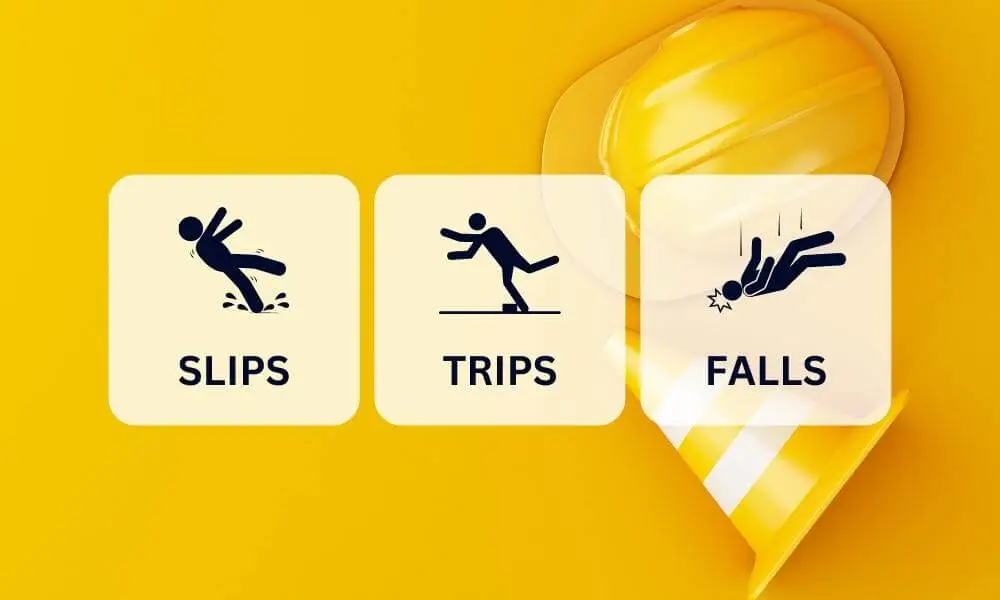Every year, countless individuals experience the unexpected mishap of a slip, trip, or fall. These incidents occur across all age groups and settings, from homes and public spaces to workplaces. While often brushed off as minor inconveniences or embarrassments, slips, trips, and falls can lead to serious injuries and significant financial and emotional costs.
The key to tackling this pervasive issue lies in understanding the factors contributing to these accidents and implementing effective prevention measures. In this blog, we delve into the causes of slips, trips, and falls, their impact, and, most importantly, how we can prevent them.
By understanding these risks, we empower ourselves to create safer environments, whether looking at the comfort of our homes, the safety of public spaces, or the well-being of employees in a workplace. This guide aims to heighten awareness, encourage preventive action, and highlight our shared responsibility in reducing the risks and consequences of slips, trips, and falls. Join us as we navigate through this important topic step by carefully step.
The Importance of Preventing Slips, Trips, and Falls
The impact of slips, trips, and falls can be highly significant, from bruised shins to broken bones. These incidents aren’t just about physical injury. The repercussions can ripple outwards, affecting an individual’s quality of life, workability, and mental well-being. In the workplace, such accidents can lead to significant downtime, loss of productivity, and even legal implications for businesses. It’s estimated that the annual costs associated with occupational falls run into billions of dollars globally, impacting not just individuals but entire economies. Therefore, it’s clear that these everyday accidents are anything but trivial and that preventing them should be a top priority for everyone.
Basic Understanding of Slips, Trips, and Falls
To prevent these incidents, we first need to understand them. So, what exactly are slips, trips, and falls? A slip occurs when there is too little friction or traction between your footwear and the walking surface, leading to a loss of balance. A trip happens when your foot or lower leg hits an object, and your upper body continues moving, resulting in loss of balance. A fall can result from a slip or trip but can also occur due to other factors, like poor lighting, lack of handrails, or sudden illness.
Each of these incidents can occur under various circumstances. While some common causes include wet or uneven surfaces, poor footwear, and cluttered walkways, there can also be less obvious contributors, like insufficient training or awareness. This article aims to delve deeper into the world of slips, trips, and falls, elucidating their causes, impacts, and, most importantly, the strategies for prevention. The goal is not to instill fear but to inspire a culture of safety, vigilance, and proactive measures to keep everyone safe.
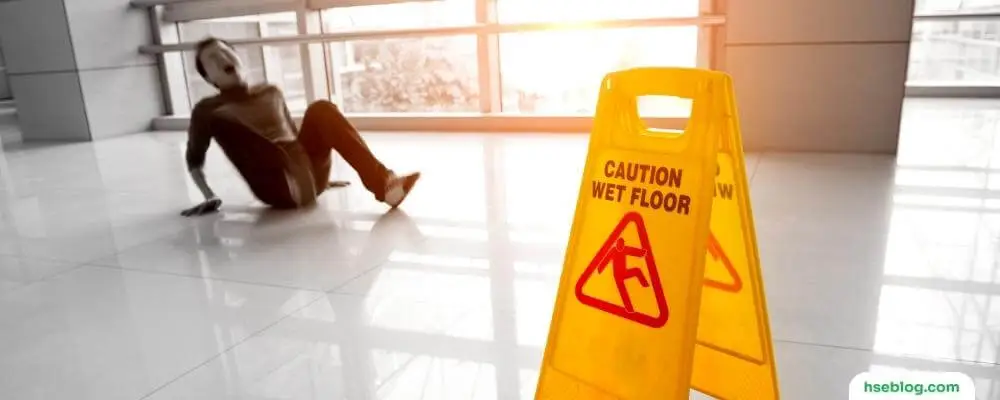
Definition and Differences: Slips, Trips, and Falls
While the terms ‘slips,’ ‘trips,’ and ‘falls’ are often used interchangeably, they refer to distinct occurrences. As we’ve already discussed, a slip occurs when there is insufficient traction between your foot and the walking surface. This lack of grip may cause an imbalance, leading you to fall.
Trips, on the other hand, occur when your foot contacts an object in its path or drops unexpectedly, causing you to lose balance. A trip might occur due to clutter, an obstacle in the pathway, or an uneven walking surface.
Finally, a fall is a sudden, uncontrolled descent for various reasons, including slips, trips, loss of consciousness, or other health-related issues. Falls can occur on the same level (for example, falling on the floor) or from one level to another (like falling down the stairs or from a ladder).
Common Causes of Slips, Trips, and Falls
Understanding the common causes of these incidents is the first step toward prevention. Below are some major factors that often contribute to slips, trips, and falls.
- Wet or Oily Surfaces: One of the most common causes of slips is the presence of wet or oily surfaces. This might occur in areas prone to spills or leaks, such as kitchens, bathrooms, and certain industrial environments.
- Uneven Surfaces, Irregularities, and Obstacles: Uneven walking surfaces or irregularities such as potholes, cracks, or abrupt transitions can cause trips. Obstacles might include clutter, cords, open drawers, and other items that haven’t been stored properly.
- Poor Lighting Conditions: Inadequate lighting can make it difficult to see and avoid potential hazards like spills, obstacles, or changes in level. This can lead to both trips and falls.
- Weather Hazards: Outdoor slips and falls often increase during bad weather conditions such as rain, snow, or ice, which make surfaces slippery and vision less clear.
- Human Factors: Rushing, distraction, fatigue, or lack of proper training can also contribute to slips, trips, and falls. These can often be mitigated through awareness and training.
- Improper Footwear: Footwear unsuitable for the work environment or the current weather conditions can increase the risk of slips, trips, and falls. For example, smooth-soled shoes might not provide enough traction on a wet or oily surface, leading to slips.
- Loose or Unsecured Mats or Rugs: Unsecured mats, rugs, or carpets can shift underfoot or present tripping hazards with their edges.
- Improper Use of Equipment: This might involve using chairs instead of ladders, climbing on shelves, or not using safety equipment correctly, all of which can lead to falls.
- Poor Housekeeping: If work and walkway areas are not kept clean and orderly, they can contribute significantly to slips, trips, and falls. Examples include cluttered workspaces, cables across walkways, or spills not promptly cleaned up.
- Lack of Safety Training: Employees not properly trained on the correct job procedures, including safety equipment, can be at higher risk for accidents.
- Inadequate Maintenance: Neglecting maintenance can lead to hazards such as leaky pipes (leading to wet surfaces), potholes, or uneven flooring, which can cause slips, trips, and falls.
- Poorly Designed Walkways: Walkways with sudden drops, absence of handrails, sharp turns, or inadequate space can increase the risk of falls.
- Medical Conditions: Certain conditions like poor vision, balance disorders, or mobility problems can also increase the risk of slips, trips, and falls.
- Age: Both the very young and the elderly are at an increased risk for falls, partly due to factors such as lack of coordination, decreased strength, or reduced balance.
Remember, while this list of causes is extensive, it is not exhaustive. There may be other contributing factors depending on the specific circumstances or environment. That’s why it’s crucial to carry out regular risk assessments to promptly identify and address potential hazards.
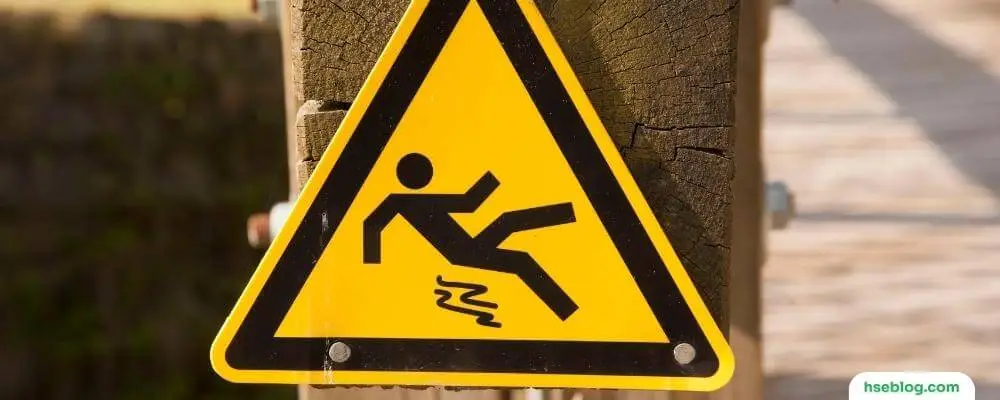
Impact and Consequences Of Slips, Trips, And Falls
The impacts of slips, trips, and falls extend beyond the immediate event and can have lasting effects on the individuals involved and the organizations they belong to. These incidents can result in physical injuries, financial costs, and psychological distress.
Physical Injuries: From Minor to Severe
Physical injuries resulting from slips, trips, and falls can range from minor to severe. Minor injuries may include bruises, abrasions, or sprains. At the same time, more severe cases can lead to fractures, concussions, or even life-threatening injuries such as traumatic brain injuries or spinal cord damage.
In some cases, these incidents can lead to chronic pain or long-term disability, affecting the individual’s ability to perform daily activities or return to work. Falls, in particular, can be especially dangerous for older adults, leading to hip fractures or other serious injuries that significantly impact their independence and quality of life.
Financial Implications: Costs of Accidents
The financial implications of these incidents are also considerable. For individuals, this can include medical expenses, rehabilitation costs, and lost wages during recovery. Additionally, they might face expenses related to modifying their home for accessibility if the fall leads to a long-term disability.
For businesses, the financial costs can be substantial. There are indirect costs besides direct costs like medical expenses and workers’ compensation claims. These can include lost productivity due to employee absence, costs related to training replacement employees, and potential increases in insurance premiums. In severe cases, businesses may also face legal fees if they are negligent in providing a safe environment.
Psychological Implications: Fear and Anxiety After a Fall
The psychological impacts of slips, trips, and falls should not be underestimated. People who have experienced such an incident may develop a fear of falling again. This fear can limit their activities, reduce their independence, and decrease their quality of life.
Anxiety, depression, and social isolation can also result from the fear of falling or the consequences of an injury, such as disability. Employees may experience stress or anxiety about returning to work, especially if they feel the environment is unsafe.
Understanding these impacts highlights the importance of preventive measures to ensure safe environments, reducing the risk of slips, trips, and falls. The following sections will explore strategies to identify potential hazards and implement effective control measures.
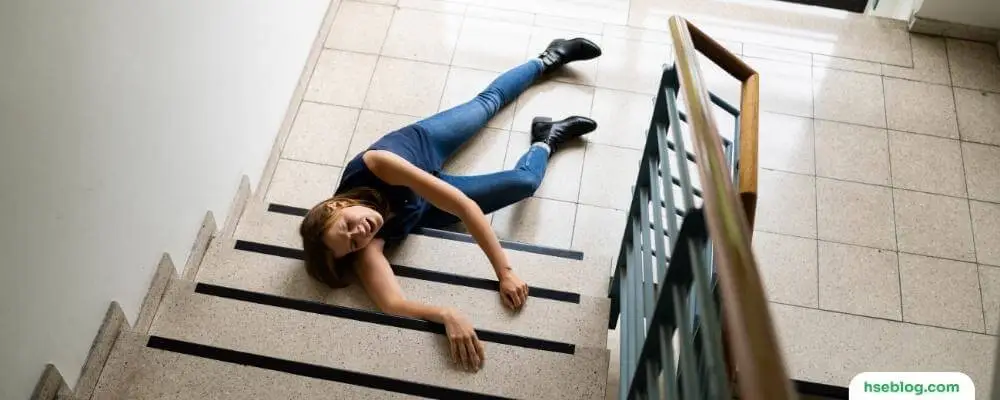
Slips, Trips, And Falls Hazards Risk Assessment
Risk assessment is critical in preventing slips, trips, and falls. It involves identifying potential hazards, evaluating their risks, and determining appropriate control measures. A thorough risk assessment should consider all areas and activities in a given environment, from the home to the workplace.
Identifying High-Risk Areas in the Home or Workplace
High-risk areas vary depending on the setting. These might include staircases, bathrooms, and kitchens in the home, where wet surfaces are common. Outdoor areas like driveways or walkways can also present risks, especially in adverse weather conditions. Any area without sufficient support structures could be risky for older adults or those with mobility issues.
In the workplace, high-risk areas could be those with heavy foot traffic, wet or uneven surfaces, or places with lots of equipment and machinery. Industrial kitchens, construction sites, warehouses, and healthcare facilities are examples of workplace environments that often have high-risk areas.
Key Considerations for Risk Assessment
A comprehensive risk assessment should consider various factors. These include:
- The Environment: Assess the condition of the floors, lighting, staircases, and walkways. Look for hazards like wet surfaces, uneven floors, poor lighting, or lack of handrails.
- Human Factors: Consider the behavior and health of individuals in the environment. Are they rushing? Are they carrying heavy items that may obstruct their view? Do they have any health conditions that increase their risk?
- Tasks: Evaluate the tasks being performed. Does the job involve working at height, handling hazardous substances, or heavy physical labor? Are workers exposed to distractions or time pressure?
- Footwear and Clothing: Assess whether appropriate footwear and clothing are worn for specific environments and tasks.
- Previous Incidents: Look at the history of slips, trips, and falls in the environment. A pattern might indicate a persistent problem that needs addressing.
Importance of Regular Safety Audits
Regular safety audits are essential to maintain a safe environment. These audits involve routinely inspecting the environment and practices to ensure that safety measures are up-to-date and effectively implemented. They help identify new or overlooked hazards and assess the effectiveness of current control measures.
Regular audits also demonstrate a commitment to safety, which can encourage individuals to take responsibility for their safety and that of others. This fosters a proactive safety culture where hazards are promptly reported and addressed, further reducing the risk of slips, trips, and falls.
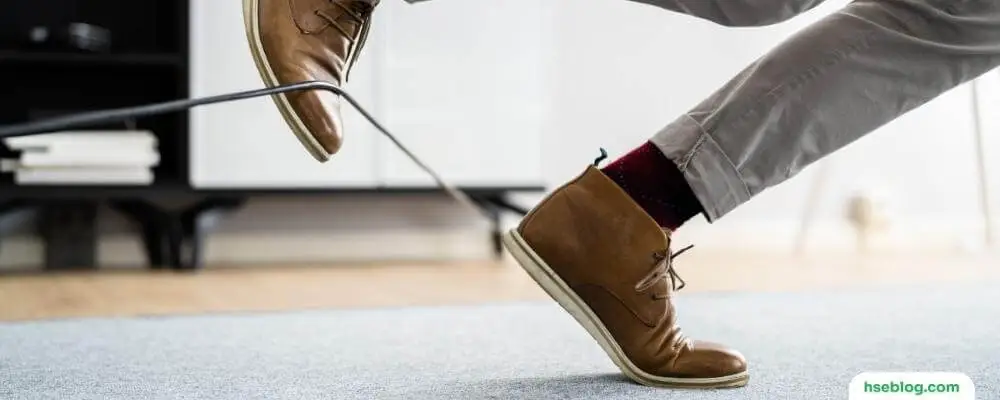
Prevention and Control Measures For Slips, Trips, And Falls
Once potential hazards have been identified through risk assessment, it’s crucial to implement prevention and control measures to mitigate these risks. This involves a range of strategies, from good housekeeping practices to installing safety features.
Housekeeping Best Practices
Proper housekeeping is one of the most effective ways to prevent slips, trips, and falls. Here are some best practices:
- Regular Cleaning: Clean floors regularly and immediately clean up any spills. Ensure to put up “wet floor” signs until the area is dry.
- Declutter: Keep walkways and work areas clear of clutter and obstacles.
- Proper Storage: Store materials and equipment properly when not in use.
- Maintenance: Promptly repair any damages to walkways and work areas, like cracks or uneven surfaces.
Installing Safety Features (Handrails, Non-Slip Mats, etc.)
Installing safety features can greatly reduce the risk of accidents. Here are a few examples:
- Handrails: Install sturdy handrails on all staircases and other areas where individuals may need extra support.
- Non-slip Mats: Use non-slip mats in areas prone to wet or slippery conditions.
- Guard Rails: Install guardrails around elevated platforms, mezzanines, and other fall hazards.
- Visible Markings: Use reflective tape or other visible markings to highlight changes in floor level or other hazards.
Appropriate Footwear for Different Surfaces
Wearing the right footwear can significantly reduce the risk of slips, trips, and falls. Choose shoes with good traction, especially for wet or slippery surfaces. Protective footwear should be worn in workplaces where specific hazards are present, such as construction sites.
Prompt Removal or Correction of Identified Hazards
Address identified hazards as quickly as possible to prevent accidents. If a hazard cannot be immediately removed or corrected, ensure it is clearly marked, and individuals are informed about it until it can be addressed.
Adequate Lighting
Ensure all areas have sufficient lighting to allow individuals to see and avoid potential hazards. This is particularly important for stairways, hallways, and outdoor paths. Replace burnt-out bulbs promptly and consider installing automatic lights in often-used areas.
By implementing these prevention and control measures, you can greatly reduce the risk of slips, trips, and falls, promoting a safer environment for everyone. In the next section, we’ll explore additional strategies and considerations specific to the workplace.
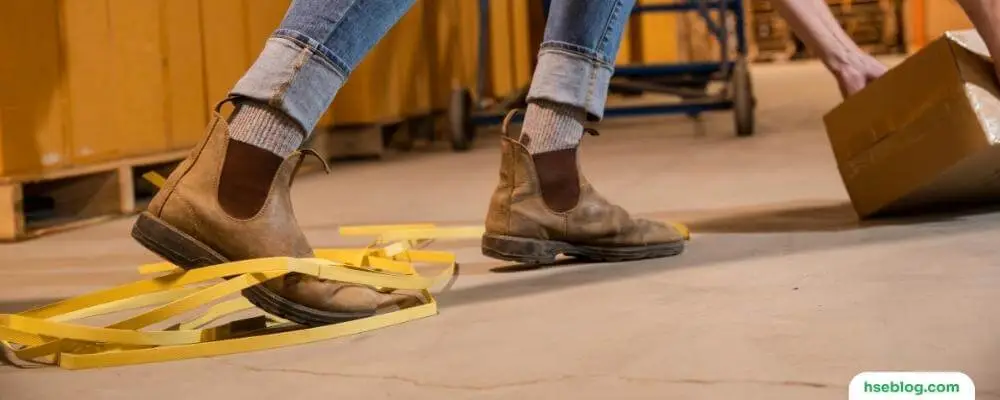
Workplace-Specific Considerations
While many of the principles of slips, trips, and falls prevention apply universally, certain considerations are particularly relevant to workplaces. These involve safety training, employer responsibilities, and industry-specific hazards.
Importance of Safety Training and Awareness Programs
Safety training is vital to workplace safety. Regular training sessions can ensure that employees are aware of potential hazards and the best practices for avoiding them. Training should cover topics such as proper use of equipment, safe handling of materials, and emergency procedures.
Awareness programs, too, can play a crucial role in maintaining a safe work environment. These programs could include regular safety reminders via bulletins, emails, or meetings, encouraging employees to be vigilant and proactive about safety.
Employer Responsibilities and Employee Rights
Employers have a responsibility to provide a safe work environment. This involves conducting regular risk assessments, addressing identified hazards promptly, and providing necessary safety training and equipment. They should also have procedures in place for reporting accidents or hazards and ensure that employees feel comfortable using these procedures without fear of retaliation.
Employees, on the other hand, have the right to a safe workplace and the right to speak up about safety concerns. They also have a role in maintaining safety by following established procedures, using provided safety equipment, and promptly reporting any hazards or incidents.
Industry-Specific Hazards and Control Measures
Every industry has its unique set of hazards, so it’s important to consider these when planning prevention and control measures. For example, spills and hot surfaces might be major hazards in a restaurant kitchen. Measures could include non-slip mats, appropriate footwear, and caution signs. In a construction site, falls from a height might be the primary concern, necessitating guardrails, safety harnesses, and fall arrest systems.
In conclusion, slips, trips, and falls are common but preventable incidents. By understanding their causes and impacts, conducting regular risk assessments, and implementing effective prevention and control measures, we can significantly reduce these accidents, fostering safer homes, workplaces, and communities.
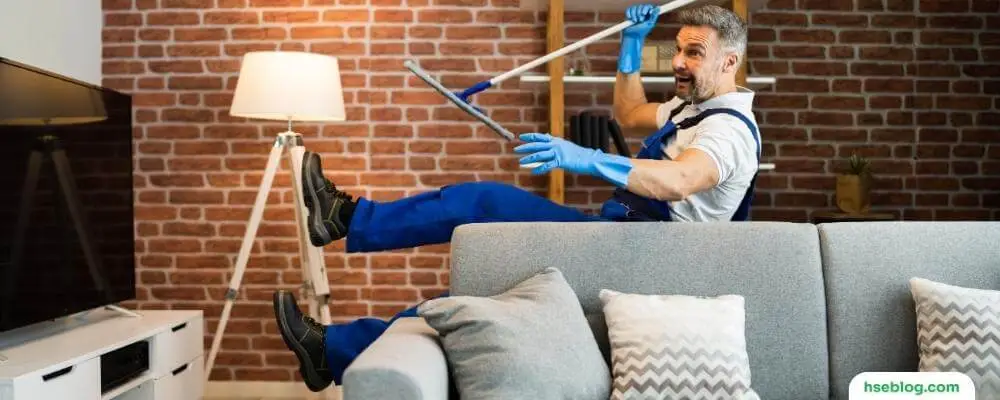
The Role of Training in Preventing Slips, Trips, and Falls
Proper training programs are essential to educate employees on recognising hazards and taking preventive measures. Key training includes:
- Slips, Trips, and Falls Training: This program focuses on identifying potential slip, trip, and fall hazards, understanding the causes and learning preventive measures. Through online slips, trips, and falls training, employees can learn how to recognize and mitigate these risks effectively and promptly report such incidents.
- Hazard Awareness Training: General hazard awareness training helps employees recognize various workplace hazards, including those that could lead to slips, trips and falls. It promotes a culture of safety and vigilance.
- Housekeeping and Workplace Organization: Training on maintaining a clean and organized workplace can prevent many trip hazards. This includes proper material storage, cable management and clear walkways.
- Emergency Response Training: Knowing how to respond in the event of a slip, trip or fall is crucial. This training covers first aid, emergency procedures and reporting protocols to ensure quick and effective response to incidents.
- Personal Protective Equipment (PPE) Training: Employees must know how to select, use and maintain their PPE. PPE training includes instructions on wearing non-slip footwear, gloves and other protective gear to minimize the risk of slips, trips and falls.
- Work at Height Training: Work at height course educates employees on the risks of working at heights and teaches safe practices for performing such tasks. This specialized training helps prevent severe injuries resulting from fall incidents.
Conclusion
Preventing slips, trips, and falls is no small task, but it is a crucial one. As we’ve explored in this guide, these incidents are far from trivial, carrying the potential for serious physical injuries, significant financial costs, and profound psychological impacts. Yet, armed with the knowledge of what causes these incidents and understanding their impacts, we’re already halfway towards prevention.
The steps to creating safer environments—at home, in public spaces, or at workplaces—aren’t overly complex. They begin with recognizing the potential hazards and involve a thoughtful blend of risk assessment, implementing practical measures, and fostering a culture of safety awareness. From basic housekeeping to installing safety features, each action reduces the risk.
It’s important to remember that the responsibility of preventing slips, trips, and falls doesn’t rest on a single individual or group—it’s a collective effort. Employers, employees, homeowners, and public facility managers all have roles to play. And in our various roles, we all contribute to a larger, shared goal: creating safer environments for everyone.
Preparing for and preventing these incidents can seem daunting in a world where the unexpected is expected. But, as we’ve seen, it’s not only possible; it’s a critical part of our commitment to safety for ourselves and others. Let this guide serve as a reminder and resource for that commitment, helping us make each step we take a safer one. Thank you for joining us on this journey towards safer environments and greater awareness. Let’s continue to take steps, big and small, toward a safer tomorrow.

